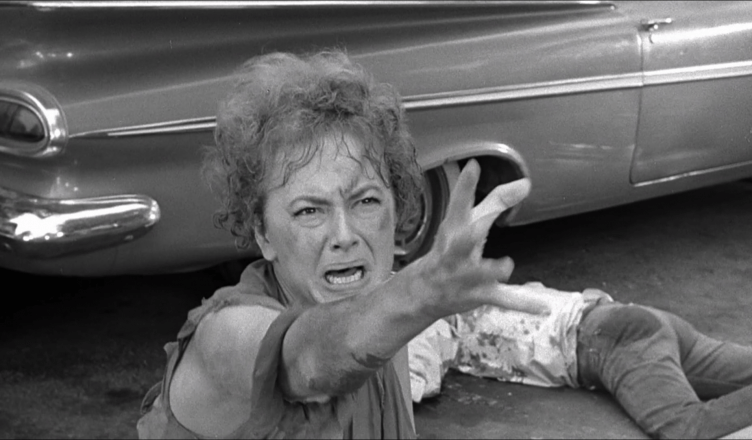Film Deets:
Director: Walter Grauman
Screenplay: Luther Davis
Actress: Olivia de Havilland
Category: Hagsploitation
Themes: Disability, Psychological Torture
Why do these screams matter?
Indicted upon its release as “a sheer projection of sadism and violence for violence’s sake,” Walter Grauman’s Lady in a Cage is a deeply confrontational meditation on how community apathy endangers vulnerable populations (Crowther). Quintessential hagsploitation in both its casting and approach, the film explicitly taps into the turbulence of the decade to showcase the tangible dangers of cultural norms that render women over forty as invisible. In the film, Mrs. Hilyard (Olivia de Havilland) becomes trapped in an elevator she has had installed in her home to assist in her recovery of a broken hip. While captive, she is tormented and assaulted by derelicts who are drawn to her home by her pleas for help.
In our first scream, Mrs. Hilyard has already suffered physically and psychologically at the hands of the juvenile delinquents who have broken into her home. She has finally managed to drag her body outside her home where she yells for help. Although her cries are ignored by people on the street, including the police, they do attract the attention of her abusers.
 What is fascinating about this scream sequence is that the words “please” and “police” are blurred together so that neither term is truly distinguishable. Despite growing evidence that Mrs. Hilyard is going to have to save herself, she still clings to the idea that some entity in authority will save her. But everyone, from the police to her neighbors to random people walking by, is so focused on themselves that they fail to see a woman crawling on the sidewalk and screaming for help. In his book Grand Dame Guignol Cinema, Peter Shelley calls this film “a disturbing indictment of the amorality of 1964 American society,” and the description is apt (50). While counterculture movements of the decade worked tirelessly to end racial segregation, address economic wealth disparities, and call for U.S. military to be pulled from Vietnam, media of the time – particularly television – tended to frame these events and their activists as potential threats to the middle class (Kisseloff 7). The film plays with a similar framing of counterculture ideology by having its young perpetrators continuously remark about Mrs. Hilyard’s wealth and how her social and class status make her a target in their eyes.
What is fascinating about this scream sequence is that the words “please” and “police” are blurred together so that neither term is truly distinguishable. Despite growing evidence that Mrs. Hilyard is going to have to save herself, she still clings to the idea that some entity in authority will save her. But everyone, from the police to her neighbors to random people walking by, is so focused on themselves that they fail to see a woman crawling on the sidewalk and screaming for help. In his book Grand Dame Guignol Cinema, Peter Shelley calls this film “a disturbing indictment of the amorality of 1964 American society,” and the description is apt (50). While counterculture movements of the decade worked tirelessly to end racial segregation, address economic wealth disparities, and call for U.S. military to be pulled from Vietnam, media of the time – particularly television – tended to frame these events and their activists as potential threats to the middle class (Kisseloff 7). The film plays with a similar framing of counterculture ideology by having its young perpetrators continuously remark about Mrs. Hilyard’s wealth and how her social and class status make her a target in their eyes.
As someone with clear economic means, Mrs. Hilyard embodies a financial privilege that removes her from the other characters in the film. She believes that if people can’t be reasoned with, at least they can be bought. But this financial privilege also puts her at risk and makes her a target. This threat is further exacerbated by other markers she believes her wealth cancels out: she’s single and alone, she’s disabled, she’s older and she’s a woman. Having been put through the wringer by the criminals, Mrs. Hilyard’s scream is one of desperation fueled by an awareness that no amount of money is going to save her. Alone on a sidewalk, she’s just another woman in crisis- and women in crisis, especially older women, in crisis are largely invisible.
And yet, for as egregious as the home invaders violence against Mrs. Hilyward is, it is the apathetic attitudes of those within Mrs. Hilyard’s social class – the so-called “productive members of society” – who also exemplify the amorality referenced by Shelley. Despite the tranquility of Mrs. Hilyard’s affluent community being shattered by her screams and desperate attempts to get away from the home invaders, the people who pass show no acknowledgement of her plight. By placing the physical and emotional abuse of the home invaders on a continuum of violence alongside the apathy of the town bystanders, the film demonstrates how societal violence is the result of community indifference and not socio-economic status.
The fact that a film making this argument was released in 1964 is not coincidental. That same year, The Civil Rights Act broke new ground for the protection of marginalized classes but the proposed bill also failed to include women as one of those protected classes (Fisher). Women’s groups were quick to decry the omission making the argument that without legal protections women were not safe existing in public spaces. Mrs. Hilyard’s screams extend those concerns to the private, domestic sphere and seem to suggest that not even wealth is enough to secure safety for women, particularly older, women with disabilities. Interestingly, the culminating scream of the film comes not from Mrs. Hilyard but from an unnamed character who screams in shock when Randall, blinded after having his eyes gouged out by Mrs. Hilyard, is brutally run down by cars as he stumbles into the street.
 A traditional scream of shock and repulsion at seeing a man’s head crushed like a melon by a car tire, this moment effectively shocks the entire community and forces them to look at the spectacle that has been right in front of them all along. Notably, the camera lingers on a group of women representing different ages and ethnicities who simply stare at Mrs. Hilyard instead of offering her help as she pulls herself by her arms out of the street. Rather than comfort her, these women stand in judgement devoid of empathy. In this moment, sisterhood is nonexistent. Equally telling, the scream that finally brings attention to Mrs. Hilyard’s plight does so unintentionally. The woman who screams is responding to seeing the death of a man play out before her eyes, not the suffering of another woman playing out at the same time. That it takes the scream of a young, able-bodied white woman in the company of a man to shock people out of their complacency is telling and reminds viewers that autonomous women past a certain age hold little cultural capital independent of their husbands. It also provides an effective contrast to our final scream in which Mrs. Hilyard is rescued but still screams to be heard.
A traditional scream of shock and repulsion at seeing a man’s head crushed like a melon by a car tire, this moment effectively shocks the entire community and forces them to look at the spectacle that has been right in front of them all along. Notably, the camera lingers on a group of women representing different ages and ethnicities who simply stare at Mrs. Hilyard instead of offering her help as she pulls herself by her arms out of the street. Rather than comfort her, these women stand in judgement devoid of empathy. In this moment, sisterhood is nonexistent. Equally telling, the scream that finally brings attention to Mrs. Hilyard’s plight does so unintentionally. The woman who screams is responding to seeing the death of a man play out before her eyes, not the suffering of another woman playing out at the same time. That it takes the scream of a young, able-bodied white woman in the company of a man to shock people out of their complacency is telling and reminds viewers that autonomous women past a certain age hold little cultural capital independent of their husbands. It also provides an effective contrast to our final scream in which Mrs. Hilyard is rescued but still screams to be heard.
Mrs. Hilyard’s screams certainly represent her anguish and anger at what she has endured, but they are also an accusation against the community that turned its back on her in a time of great need. The supposed safety net of community, particularly one with economic resources, is shown to be an illusion as the crowd that surrounds Mrs. Hilyard aren’t as interested in engaging with her trauma as much as they are simply observing it. The murmurs of the crowd that overtake Mrs. Hilyard’s voice suggest that even though she was rescued from this threat, she is still vulnerable because no one is really listening to her. They never were.
Works Cited
Crowther, Bosley. “Socially Hurtful; Lady in a Cage is a Reprehensible Film,” The New York Times, June 21, 1964, Section X, Page 1.
Fisher, Allen. “Women’s Rights and the Civil Rights Act of 1964.” National Archives, n.d.
Kisseloff, Jeff. Generation on Fire: Voices of Protest from the 1960s, An Oral History. University Press of Kentucky, 2006.
Lady in a Cage. Directed by Walter Grauman, performances by Olivia de Havilland, Ann Sothern, and James Caan, Paramount Pictures, 1964.
Shelley, Peter. Grande Dame Guignol Cinema: A History of Hag Horror from Baby Jane to Mother. McFarland & Co., 2009.






